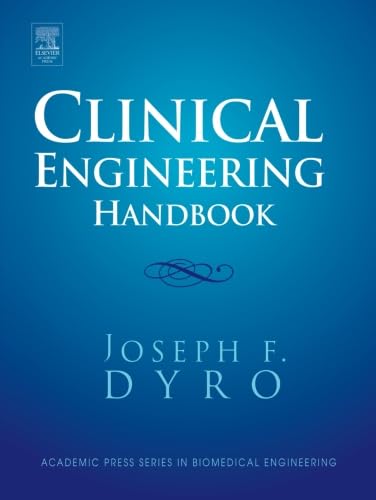Items related to Clinical Engineering Handbook

"synopsis" may belong to another edition of this title.
For brevity’s sake I shall give an overview of the major sections of this text. Section one covers clinical engineering history, roles, models (academic, regional, military), job descriptions, and careers. Section two gives an overview of worldwide practices in clinical engineering, with example chapters covering the practice in several countries, such as Estonia, Paraguay and Japan. Section three gives an overview of healthcare technology management topics, covering good manufacturing practices, outsourcing, maintenance and repair, etc. There are several useful forms and flowcharts to be found here. Section four reviews management styles, finances, personnel matters, skills needed, and quality assurance. Section five reviews several topics involving safety, such as risk management, best practices, accidents, and special cases involving electrical safety and electromagnetic interference. Section six reviews the education and training of clinical engineers, including reviews of practices in North America and Germany, internships, BET licensing, the use of workshops and distance education, etc. Section seven reviews the design, manufacture, evaluation and control of medical devices. It includes some useful material on human factors, liability, and Institutional Review Boards. Medical Devices, Utilization and Service is the title of section eight. This section reviews devices commonly used in different sections of the hospital (e.g. anesthesiology and perinatology) and as well discusses troubleshooting techniques. Section nine reviews information sources, transmission, and processing. Included are sections on PACS, Telemedicine, Wireless Medical Telemetry, Virtual Instruments, and the effects of the HIPA Act. Section ten reviews several topics often relegated to environmental and plant engineers, such as HVAC, Electrical Power considerations, Radiation Safety, Sanitation, Construction and Renovation, Water Systems, and Disaster Planning. Section eleven reviews Medical Device Standards, Regulations, and the Law. This is mandatory reading for all engineering involved in medicine. It covers JCAHO Accreditation, AAMI and ANSI standards, the FDA and other regulatory agencies, liability law, and ISO standards. Section twelve briefly reviews professionalism and ethics in clinical engineering practice, and gives some examples of professional organizations in New England and in Germany. Section thirteen, the final part of the text, briefly addresses some potential future trends in clinical engineering practice and some of the trends that may affect it.
To reiterate: this is an exceedingly comprehensive handbook. The field of clinical engineering (worldwide) is very well described here. While the level of each individual chapter varies considerably (from one page summaries to multiple page well-documented and illustrated chapters) this text overall will be very useful as a reference text for practitioners and students of clinical engineering. Many individual chapters will serve as teaching material for lectures in clinical and bioengineering courses.
The page count and purchase price of this text were obtained from the Academic Press web site, and may not be accurate as of the publication date. (This review was based upon page proofs.)
The editor and each author are to be congratulated for their contribution to the literature in this field.
Reviewed by:
Paul H. King, Vanderbilt University
__________________________________________________
The Clinical Engineering Handbook makes an excellent resource, particularly to someone newly entering or thinking about entering the field. It provides a good background to the wide array of tasks, programs, innovations and challenges to the clinical engineering profession...Overall, the handbook is well written and the breakdown into very specific chapters makes referencing easy. - ACCE News, Nov./Dec. 2004
__________________________________________________
"The Clinical Engineering Handbook makes an excellent resource, particularly to someone newly entering or thinking about entering the field. It provides a good background to the wide array of tasks, programs, innovations, and challenges to the clinical engineering profession." - Journal of Clinical Engineering, June 2005
A volume in the Biomedical Engineering Series
- The most up-to-date book available on the subject of clinical engineering
- Over 170 contributions by leaders in the field of clinical engineering
- Advocacy efforts and professional stature will be enhanced by the publication of this definitive, comprehensive text on clinical engineering
As the biomedical engineering field expands throughout the world, clinical engineers play an evermore-important role as translators between the medical, engineering, and business professions. They influence procedure and policy at research facilities, universities, as well as private and government agencies including the Food and Drug Administration and the World Heath Organization. The profession of clinical engineering continues to seek its place amidst the other professionals that comprise the health care team.
The Clinical Engineering Handbook meets a long felt need for a comprehensive book on all aspects of clinical engineering that will be suitable as a reference in the hospital, classroom, workshop as well as governmental and non-governmental organizations. The Handbook’s thirteen sections address the following areas: Clinical Engineering; Models of Clinical Engineering Practice; Technology Management; Safety Education and Training; Design, Manufacture, and Evaluation and Control of Medical Devices; Utilization and Service of Medical Devices; Professionalism and Ethics. The Handbook of Clinical Engineering provides the reader with prospects for the future of clinical engineering as well as guideline and standards for best practice around the world. From Telemedicine and IT issues, to sanitation and disaster planning, it brings together all the important aspects of clinical engineering.
Related titles:
Enderle, Blanchard, Bronzino; Introduction to Biomedical Engineering, 01222386604, 1999.
"About this title" may belong to another edition of this title.
- PublisherAcademic Press
- Publication date2012
- ISBN 10 0123958113
- ISBN 13 9780123958112
- BindingPaperback
- Number of pages696
Buy New
Learn more about this copy
Shipping:
£ 10
From United Kingdom to U.S.A.
Top Search Results from the AbeBooks Marketplace
Clinical Engineering Handbook
Book Description Paperback. Condition: Brand New. 696 pages. 11.00x8.27x1.57 inches. In Stock. Seller Inventory # zk0123958113
Clinical Engineering Handbook
Book Description Condition: New. Book is in NEW condition. Seller Inventory # 0123958113-2-1
Clinical Engineering Handbook
Book Description Condition: New. New! This book is in the same immaculate condition as when it was published. Seller Inventory # 353-0123958113-new

